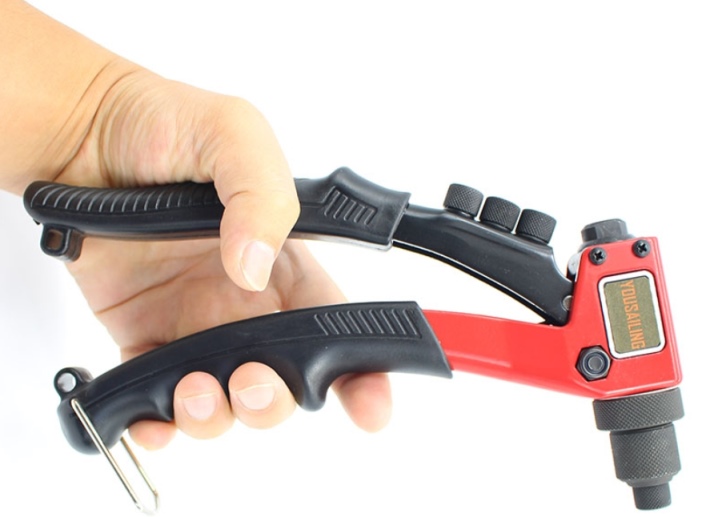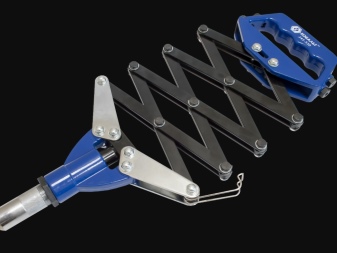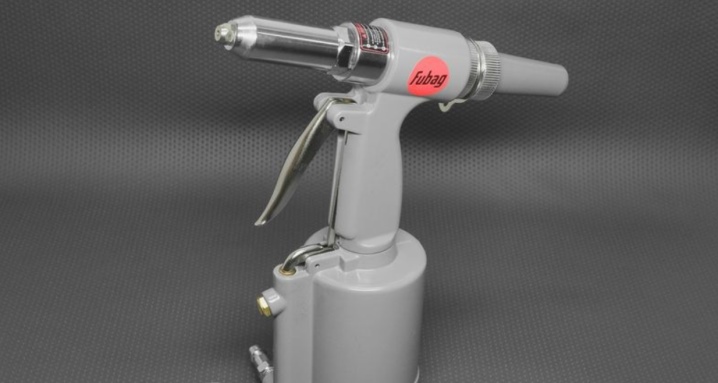What are riveters and how to use them?

What is a riveter, how a riveter works, how to use it - such questions regularly arise among those who first encounter the need to use this hand tool. This method of connection has been successfully used for many years, it is no less reliable than welding or screws. How to choose a rivet gun, the principle of its operation and the ranking of the best models should be discussed in more detail.

What it is?
A riveter or riveter is a hand-held device that can be used to create a permanent connection in metal parts. Unlike electrical devices, all actions here occur exclusively due to mechanical action. The riveting machine looks quite simple, visually similar to pliers, but with a lateral arrangement of the jaws. The structure always contains such elements.
- Head. It is to it that the rivet that is to be installed is attached. It is selected according to the size of the hardware to provide a convenient grip of the rod with the collet mechanism.
- Lever. When you press it, the mechanism starts to move. The force is applied from both sides, with the closing of its parts.
- Frame. It includes a fixed lower handle and a tool support bed.
- Clamping mechanism. Responsible for the transfer of force from the handles to the head. In rivets, it can be threaded and pulled. In the second type of construction, it consists of a sleeve and collet jaws.
- Spring. Used when removing the core, creates pressure by resting against the housing cover.
This is a fairly simple device with which you can quickly fasten sheets or parts of metal parts without using a welding machine or selecting screws. In addition to manual modifications, there are also electrical, pneumatic and battery options., but the most popular is the mechanical version: inexpensive and reliable.
With the help of a riveter, materials limited in thickness can be fastened - up to 10-13 mm. The resulting joint has its advantages: it is non-separable, resistant to vibration loads even without additional sealing - this is especially highly valued in shipbuilding, where welds do not provide sufficient reliability.
The main purpose of this tool is to join flat parts. Riveting is most effective when the width of the contact points is 3 times or more than the thickness.

Principle of operation
The riveter works, regardless of the type of device, according to the same principle. All actions are reduced to the transfer of force to the tool head. It can be supplied mechanically, pneumatically or electrically, depending on the modification. A hole of the desired diameter is made in the metal blank, into which the rivet is inserted. A clamping mechanism is brought to it - an installer that allows you to deform the hardware. After exposure to it, the skirts of the rivets change their position, flatten, and the fastening itself acquires the necessary strength and rigidity.
Initially, the riveting process took place under shock loads. With the advent of rivets, the pull-out method of action has become the most popular.A hardware with a finished head at the end is threaded through a hole in the metal, its metal rod is fixed in the tool setting tip. When a force is applied to the head, squeezing and formation of the mating part of the connection occurs. From the tear-off side, the cap, if necessary, is sealed.


Main characteristics
Like any other tool, the riveter has certain performance and performance characteristics. The most important of these parameters deserve more detailed consideration.
Materials (edit)
The tool is made of durable tool steel or chrome steel, which can withstand regular intense loads. There are also aluminum rivets, their handles are made of chrome-molybdenum alloy. Grip attachments or their cover are most often made of PVC plastic. Rarely are silumin rivets made of an aluminum-silicon alloy - they are less durable, more like staplers in their application.

Dimensions and weight
The size range of the hand tool is not too large. The following parameters are considered standard:
- length from 210 to 500 mm;
- chuck diameter (inner part) 2.4-8 mm;
- head length from 24 to 70 mm;
- weight 300-1100 g.
Electric and pneumatic models are heavier, have a different range of dimensions. Working elements for riveters are most often standardized for all varieties. Models of the "accordion" type are the most massive - weighing up to 4 kg. For standard manual versions, the most popular version is 440 mm with a 2.6 × 42 mm chuck.


Equipment
The standard equipment of the manual riveter can be supplemented with useful accessories. Commonly used here:
- replaceable nozzles of popular standard sizes;
- adjusting screw for limiting travel on the body;
- plastic tips for handles with a lock;
- assembly wrench for changing heads;
- threaded mandrels for rivet nuts.
This is a basic checklist of what should be included with a quality hand held riveter. It is worth considering that for threaded tools, the number of available nozzles is often larger, since it is focused on other diameters: 5.6, 8, 10 mm. Screws have their own size range of fasteners: 2.4 mm, 3.2 mm, 4 mm, 4.8 mm, 6 mm, 6.4 mm.

Species overview
A rivet gun or an industrial press riveter, a universal mechanical version or a reinforced lever device - all these tools are united by a common principle of operation and a method of installing fasteners. Today there are models with a swivel head (jaws), professional machines and classic "accordions". The impact method of riveting is practically not used anymore; such devices are gradually being phased out. Electric and pneumatic tools are offered to replace them. It is worth talking about the device and what modern riveters are like in more detail.

Mechanical
Models with manual drive and the most simple device. They have a primitive design and are operated by squeezing the arms. The range of installed rivets is not too large; when working with large diameter products, it is better to give preference to more powerful options. Mechanical gadgets are best used in the home workshop.

By the location of the head, manual riveters are classified as follows.
- End. The head is located at the top of the tool, in the same direction as the body. The mount is located at the end.
- Corner. The head is located on the side of the body. Usually attached at right angles, but there are other options.
- Double-sided. With such a model, you can rearrange the head from the end to the side using a landing key. This is useful if you need to access a part that is not directly accessible.
- Two-position. Here, no special tool is required to change the position of the head.It can be easily fixed at the desired angle of 180 or 90 degrees.
- Swivel. Here, the tool uses a hinge mechanism to support 360-degree rotation of the working tip. You can choose any convenient position of the head and fix it.
These are the main types of heads used in the construction of hand riveters.


Electrical
Such models are made in the form of an assembly gun with replaceable nozzles and a "trigger", when pressed, a force is applied to the head. The power tool requires a connection to the mains power supply. It is more productive than manual counterparts, the work is carried out practically without effort on the part of the master.
The use of electric rivets is advisable only in continuous operation.

Pneumatic
The devices do not look like tongs, but an assembly gun, in the tail section there is a compressor that pumps compressed air. This is the most powerful option to ensure the successful installation of large rivets. It is advisable to purchase such equipment if the work on the installation of the permanent connection is carried out regularly and in large volumes.


Rechargeable
They are a subspecies of electrical models, but have a self-contained battery. Due to this, their power is significantly lower, the period of continuous operation is determined by the capacity of the battery and the intensity of its charge consumption. Such models are mobile and can be used where there is no network connection. The delivery set may not include a battery or a charger, they have to be purchased additionally.


Pneumohydraulic
Professional, industrial version of the equipment. It is used for working with large-sized threaded rivets. High clamping force gives such a tool the ability to fasten parts in especially critical nodes without the risk of their destruction. The main field of application of pneumohydraulic rivets is shipbuilding, mechanical engineering.


One-handed
They are also called rivet staplers. This is a tool with 1 working handle and a fixed body. Since such products are made from silumin, the strength of the mechanism is minimal. Suitable only for working with rivets made of aluminum, plastic and other soft materials. Fastener diameters are often limited to 4.9 mm.


Two-handed
A universal tool in which both handles are movable. Provides high compression force, suitable for working with all metal rivets, including stainless. Also, two-handed rivets are called lever, according to the principle of action. They are classified in the professional category with an extended working range.

Backstage
Also known as accordion or lever-folding riveter. This tool is used when installing hard-to-reach rivets. A special mechanism creates force when folding the sliding parts, the handle acts as a pressure lever. The riveter's convenience lies in the fact that you can work with it with one hand.


Riveting hammers
A variety of professional riveters that use impact force to set hardware. An important difference in its work is the need for wedging fasteners on both sides, which requires free access to each part of the workpiece or part. The main field of application of such equipment is the repair and maintenance of equipment in the machine-building and shipbuilding industries. Riveting is carried out on cold and hot surfaces, the diameter of the hardware can reach 36 mm. Not used in everyday life.


Adapters
Made in the form of a nozzle that can be installed in drills or screwdrivers. Most often they are produced in the form of an option for a specific type of rivets, but there are also universal options. They are inexpensive, designed mainly for low productivity.

Fume hoods
Designed to work with the corresponding type of rivets. Consumables for them are inexpensive, completely cover the hole in the workpiece. This type of tool is most often found among manual options.
Threaded
Designed to work with rivets that have a hollow tube with an internal thread. A hairpin with a guy wire is screwed into it. Such a tool is found among both manual and electric or pneumatic models. The connection is considered more reliable.


Rating of the best manufacturers
It is not difficult to compose the top of the best brands that release riveters on the market. They are presented in the assortment of the most famous companies. Among the leaders are such firms.
- Metabo. A German brand that produces powerful and reliable electric rivets. The range includes wired and rechargeable models.


- Matrix. One of the most popular brands in Russia. It produces manual accordion riveters and professional two-handed rivets, there are rotary models and options for anchors.

- "Bison". It produces mainly manual riveters, the quality level is average, but the equipment is quite satisfactory for both amateurs and professionals.

- Messer. The company specializes in professional grade electric wire rivets.


- Haskyy. The manufacturer offers for sale hand tools, mainly for threaded connections. A distinctive feature is the rich set of products offered.

- Fubag. The brand specializes in the production of household or industrial grade electric and pneumatic rivets. Portable models are easy to use, but somewhat massive.

- Stanley. Renowned manufacturer of tools for the home. Its riveters are single-lever, focused on working with soft metals, and are distinguished by a budget price.


How to choose?
When choosing a riveter, it is important to pay attention to a number of important points.
- Appointment of the tool. For the home, you should choose the simplest options - for aluminum rivets, even a one-hand option or an "accordion" is suitable. For steel and stainless steel, it is better to purchase two-handed manual models. Professional equipment for riveting metal of different thicknesses is required only for those who are engaged in production, repair and construction.
- Features of fasteners. For example, for a drywall profile, a conventional one-hand lever-type cutter is suitable. For Molly dowels and for anchors of this type, choose similar models. For semi-hollow rivets, you need a pulling tool that is simple and straightforward to use.
- Manufacturing material. It must be tool steel of sufficient thickness. This point is especially important for professional use. Silumin and aluminum options are not even worth considering.
- Head type. If you have to carry out work in different conditions, it is better to immediately choose a model with a rotary mechanism. For not too frequent installation of rivets at home, you can get by with a simple straight or angled option.
- Equipment. The wider it is, the less you will have to buy additional accessories in the end. In addition, the tool must have the necessary mounting keys and other devices to facilitate the work of the master.
- Weight and power. A quality riveter is always quite heavy, its weight is close to 1 kg or more. The most powerful models are pneumatic, electric corded ones are inferior to them, but such performance is required only when the tool is used in-line. If this is not required, it is better to choose a manual option or a drill adapter.
These are the main criteria that can be followed when choosing a riveter for use in a home workshop.

How to use it correctly?
In order to easily rivet any metal parts, you need to study the rules for using the riveter. About what kind of adjustment is required for a hand tool, how to install hardware when working with it, it is worth learning in more detail before starting to use the tool.
Threaded nut rivet
This tool takes some effort to work with. The procedure in this case will be as follows.
- A hole with a diameter of 3 to 14 mm (M3-M14) is drilled in the steel workpiece. Reference point - riveting diameter.
- Insert the threaded rod into the riveting head.
- Screw the boss onto it. The action continues until the stop appears.
- Install the prepared hardware into the hole in the parts to be joined.
- Reduce the levers to generate the required effort.
- Unscrew the tool from the rivet joint.
The fastening obtained in this way allows you to immediately screw a bolt or stud of the desired diameter into the part. The connection is strong and reliable, usually does not require additional sealing.

"Harmonic"
This type of tool requires, when working, to ensure sufficient free space for folding its elements. In addition, the length of the straightened lever part reaches 80 cm. This one should also be taken into account when preparing the workplace. The head in accordion rivets is always straight. In this case, you need to install the hardware as follows.
- Fasten the rivet in the head. Installation is carried out inside with a hairpin.
- Unclench the handle all the way.
- Insert the rivet into the prepared hole.
- Compress the mechanism, gradually increasing the pressure due to body weight.
- Remove the pin from the head.
The big advantage is that all manipulations are done with one hand. This makes it easier to position the rivets in the hole, allowing less fatigue with a large volume of tasks.

Exhaust
The principle of operation here is similar to that used in accordion riveters. Only the lever of the tool is located differently and requires the application of force from 2 sides. The cartridge is selected based on the size of the stud. The tool, when compressed, flattens the boss installed in the hole, riveting of the material occurs. The inner stud is pulled out.
Surplus hardware sticking out in the material can be easily removed with wire cutters at the end of the work. When working with blind rivets, it is important to remember the correct selection of consumables. The length of the boss should be 2 times the thickness of the elements to be fastened, otherwise it will not work to connect them.

The following video explains how to use the riveter.










The comment was sent successfully.